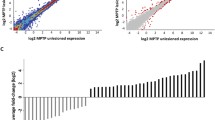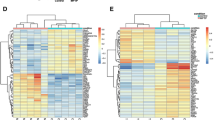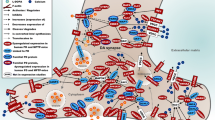Abstract
Possible cell death mechanisms for pars compacta nigro-striatal dopamine neurons in Parkinson’s disease include oxidative stress, inflammatory processes, nitric oxide, iron accumulation, glutamate toxicity and diminished neurotrophic factor responses. There is a notion that Parkinson’s disease is not a single disorder but a syndrome that can be initiated by several factors. Because of limitations of biochemical methods in the global analysis of neuronal death, a full picture of events has not been established. However, recently developed cDNA microarray or microchips, in which the global expression of thousands of genes can be assessed simultaneously, is changing the prospect for understanding the disease process, its progression, response to drugs, etc. The neurotoxin N-methyl-4-phenyl-1,2,3,6-tetrahydropyridine (MPTP) is considered the most valid model of Parkinson’s disease. We employed the technique of cDNA microarray gene expression to determine the mechanism of action of MPTP in mouse substantia nigra. Also, we studied neuroprotective processes induced by several compounds, including R-apomorphine and the green tea polyphenol epigallo-catechin-3-gallate (EGCG). This was done in two ways: (1) the time-dependent acute effect of MPTP, for determining which of the initial genes might lead to dopamine neuron death and (2) gene expression at the time of MPTP-induced dopamine neuron death. We observed that early (acute MPTP) gene expression differs from effects seen at the time of death (chronic MPTP), and that early gene changes are crucial for setting into action genes that eventually cause dopamine neuron death. Furthermore, this process is a cascade of “domino” effects, some of which were previously established by biochemical means. However, our findings show an additional large number of events previously unknown. The neuroprotective drugs reversed some but not all of the gene expression, suggesting involvement of these genes in the neurodegenerative process. Because of the profound complexity of “domino” effect it is now reasonable to understand why a single neuroprotective drug has not shown clinical neuroprotective efficacy. Future multi neuroprotective drugs may be necessary for treatment of not only Parkinson’s disease, but other neurodegenerative diseases (e.g. Alzheimer’s disease) and detrimental states (e.g. ischaemia).
Similar content being viewed by others
References
Ara, J., Przedborski, S., Naini, A.B., Jackson-Lewis, V., Trifiletti, R.R., Horwitz, J. and Ischiropoulos, H. (1998) “Inactivation of tyrosine hydroxylase by nitration following exposure to peroxynitrite and 1-methyl-4-phenyl-1,2,3,6-tetrahydropyridine (MPTP)”, Proc. Natl Acad. Sci. USA 95, 7659–7663.
Arawaka, S., Saito, Y., Murayama, S. and Mori, H. (1998) “Lewy body in neurodegeneration with brain iron accumulation type 1 is immunoreactive for alpha-synuclein”, Neurology 51, 887–889.
Ben-Shachar, D., Eshel, G., Finberg, J.P. and Youdim, M.B. (1991) “The iron chelator desferrioxamine (Desferal) retards 6-hydroxydopamine-induced degeneration of nigrostriatal dopamine neurons”, J. Neurochem. 56, 1441–1444.
Berg, D., Gerlach, M., Youdim, M.B.H., Double, K.L., Zecca, L., Riederer, P. and Becker, G. (2001). “Brain iron pathways and their relevance to Parkinson’s disease”, J. Neurochem. 79, 225–236.
Bessler, H., Dialdetti, R., Salman, H., Bergman, M. and Djaldetti, M. (1999) “IL-1 beta, IL-2, IL-6 and TNF-alpha production by peripheral blood mononuclear cells from patients with Parkinson’s disease”, Biomed. Pharmacother. 53, 141–145.
Cadet, J.L., Jayanthi, S., McCoy, M.T., Vawter, M. and Ladenheim, B. (2001), “Temporal profiling of methamphetamine-induced changes in gene expression in the mouse brain: evidence from cDNA array”, Synapse 41, 40–48.
Debouck, C. and Goodfellow, P.N. (1999) “DNA microarrays in drug discovery and development”, Nat. Genet. 21, 48–50.
Ebadi, M., Govitrapong, P., Sharma, S., Muralikrishnan, D., Shavali, S., Pellett, L., Schafer, R., Albano, C. and Eken, J. (2001) “Ubiquinone (coenzyme q10) and mitochondria in oxidative stress of Parkinson’s disease”, Biol. Signals Recept. 10, 224–253.
Gassen, M., Gross, A. and Youdim, M.B. (1998) “Apomorphine enantiomers protect cultured pheochromocytoma (PC12) cells from oxidative stress induced by H2O2 and 6-hydroxydopamine,” Mov. Disord. 13, 242–248.
Gerlach, M., Ben-Shachar, D., Riederer, P. and Youdim, M.B.H. (1994) “Altered brain metabolism of iron as a cause of neurodegenerative diseases?”, J. Neurochem. 793, 793–807.
Grunblatt, E., Mandel, S., Berkuzki, T. and Youdim, M.B.H. (1999) “Apomorphine protects against MPTP-induced neurotoxicity in mice”, Mov. Disord. 14, 612–618.
Grunblatt, E., Mandel, S., Maor, G. and Youdim, M.B.H. (2001a) “Effects of R-apomorphine and S-apomorphine on MPTP-induced nigro-striatal doamine neuronal loss”, J. Neurochem. 77, 146–156.
Grunblatt, E., Mandel, S., Maor, G. and Youdim, M.B.H. (2001b) “Gene expression analysis in MPTP mice model of Parkinson’s disease using cDNA microarray”, J. Neurochem. 78, 1–12.
Gunshin, H., Mackenzie, B., Berger, U.V., Gunshin, Y., Romero, M.F., Boron, W.F., Nussberger, S., Gollan, J.L. and Hediger, M.A., (1997) “Cloning and characterization of a mammalian protoncoupled metal-ion transporter”, Nature 388, 482–488.
Hadjiconstantinou, M., Fitkin, J.G., Dalia, A. and Neff, N.H. (1991) “Epidermal growth factor enhances striatal dopaminergic parameters in the 1-methyl-4-phenyl-1,2,3,6-tetrahydropyridine-treated mouse”, J. Neurochem. 57, 479–482.
Hanson, E.S. and Leibold, E.A. (1999) “Regulation of the iron regulatory proteins by reactive nitrogen and oxygen species”, Gene Expr. 7, 367–376.
Hentze, M.W. and Kuhn, L.C. (1996) “Molecular control of vertebrate iron metabolism: mRNA-based regulatory circuits operated by iron, nitric oxide, and oxidative stress”, Proc. Natl. Acad. Sci. USA 93, 8175–8182.
Hunot, S., Brugg, B., Ricard, D., Michel, P.P., Muriel, M.P., Ruberg, M., Faucheux, B.A., Agid, Y. and Hirsch, E.C. (1997) “Nuclear translocation of NF-kappaB is increased in dopaminergic neurons of patients with Parkinson disease”, Proc. Natl. Acad. Sci. USA 94, 7531–7536.
Ishii, T., Yanagawa, T., Yuki, K., Kawane, T., Yoshida, H. and Bannai, S. (1997) “Low micromolar levels of hydrogen peroxide and proteasome inhibitors induce the 60-kDa A170 stress protein in murine peritoneal macrophages”, Biochem. Biophys. Res. Commun. 232, 33–37.
Jellinger, K.A. (2001) “The pathology of Parkinson’s disease”, Adv. Neurol. 86, 55–72.
Jellinger, K., Paulus, W., Grundke-Iqbal, I., Riederer, P. and Youdim, M.B.H. (1990) “Brain iron and ferritin in Parkinson’s and Alzheimer’s diseases”, J. Neural Transm. Parkinson’s Dis. Dementia Sect. 2, 327–340.
Kim, S. and Ponka, P. (1999) “Control of transferrin receptor expression via nitric oxide-mediated modulation of iron-regulatory protein 2”, J. Biol. Chem. 274, 33035–33042.
Kim, S. and Ponka, P. (2000) “Effects of interferon-gamma and lipopolysaccharide on macrophage iron metabolism are mediated by nitric oxide-induced degradation of iron regulatory protein 2”, J. Biol. Chem. 275, 6220–6226.
Kumer, S.C. and Vrana, K.E. (1996) “Intricate regulation of tyrosine hydroxylase activity and gene expression”, J. Neurochem. 67, 443–462.
Lander, F.S., Linton, L.M., Birren, B., Nusbaum, C. et al., (2001) “Mutation in the gene encoding ferritin light polypeptide causes dominant adult-onset basal ganglia disease”, Nat. Genet. 28, 350–354.
LaVaute, T., Smith, S., Cooperman, S., Iwai, K., Land, W., Meyron-Holtz, E., Drake, S.K., Miller, G., Abu-Asab, M., Tsokos, M., Switzer, 3rd, R., Grinberg, A., Love, P., Tresser, N. and Rouault, T.A. (2001) “Targeted deletion of the gene encoding iron regulatory protein-2 causes misregulation of iron metabolism and neurodegenerative disease in mice”, Nat. Genet. 27, 209–214.
Levites, Y., Youdim, M.B.H., Maor, G. and Mandel, S. (2002) “Attenuation of 6-hydroxydopamine (6-OHDA)-induced nuclear factor-kappaB (NF-kappaB) activation and cell death by tea extracts in neuronal cultures”, Biochem. Pharmacol. 63, 21–29.
Lin, L.F., Doherty, D.H., Lile, J.D., Bektesh, S. and Collins, F. (1993) “GDNF: a glial cell line-derived neurotrophic factor for midbrain dopaminergic neurons [see comments]”, Science 260, 1130–1132.
Lin, M., Rippe, R.A., Niemela, O., Brittenham, G. and Tsukamoto, H. (1997) “Role of iron in NF-kappa B activation and cytokine gene expression by rat hepatic macrophages”, Am. J. Physiol. 272, G1355-G1364.
Mandel, S., Grunblatt, E. and Youdim, M.B.H. (2000a) “cDNA microarray to study gene expression of dopaminergic neurodegeneration and neuroprotection in MPTP and 6-hydroxydopamine models: implications for idiopathic Parkinson’s disease”, J. Neural. Transm. Suppl. 60, 117–124.
Mandel, S., Levites, Y., Maor, G. and Youdim, M.B.H. (2000b) “Neuroprotection by black and green tea extracts involves inhibition of translocation and activity of NFkappaB in neuronal cells”, Neurosci. Lett. Suppl., 55.
Mandel, S., Grunblatt, E., Levites, Y., Maor, G. and Youdim, M.B.H. (2002a) “Molecular events in neurodegeneration and neuroprotection in Parkinson’s Disease and its animal model MPTP as assessed by cDNA microarray”, Adv. Neurol., In Press.
Mandel, S., Grunblatt, E., Maor, G. and Youdim, M.B.H. (2002b) “Early and late gene changes in MPTP mice model of Parkinson’s disease employing cDNA microarray”, Neurochem. Res., In-Press.
Mochizuki, H., Imai, H., Endo, K., Yokomizo, K., Murata, Y., Hattori, N. and Mizuno, Y. (1994) “Iron accumulation in the substantia nigra of 1-methyl-4-phenyl-1,2,3,6-tetrahydropyridine (MPTP)-induced hemiparkinsonian monkeys”, Neurosci. Lett. 168, 251–253.
Mogi, M., Harada, M., Narabayashi, H., Inagaki, H., Minami, M. and Nagatsu, T. (1996) “Interleukin (IL)-1 beta, IL-2, IL-4, IL-6 and transforming growth factor-alpha levels are elevated in ventricular cerebrospinal fluid in juvenile parkinsonism and Parkinson’s disease”, Neurosci. Lett. 211, 13–16.
Mogi, M., Togari, A., Ogawa, M., Ikeguchi, K., Shizuma, N., Fan, D., Nakano, I. and Nagatsu, T. (1998) “Effects of repeated systemic administration of 1-methyl-4-phenyl-1,2,3,6-tetrahydropyridine (MPTP) to mice on interleukin-1beta and nerve growth factor in the striatum”, Neurosci. Lett. 250, 25–28.
Monteiro, H.P. and Winterbourn, C.C. (1989) “6-Hydroxydopamine releases iron from ferritin and promotes ferritin-dependent lipid peroxidation”, Biochem. Pharmacol. 38, 4177–4182.
Ostrerova-Golts, N., Petrucelli, L., Hardy, J., Lee, J.M., Farer, M. and Wolozin, B. (2000) “The A53T alpha-synuclein mutation increases iron-dependent aggregation and toxicity”, J. Neurosci. 20, 6048–6054.
Rathke-Hartlieb, S., Kahle, P.J., Neumann, M., Ozmen, L., Haid, S., Okochi, M., Haass, C. and Schulz, J.B. (2001) “Sensitivity to MPTP is not increased in Parkinson’s disease-associated mutant alpha-synuclein transgenic mice”, J. Neurochem. 77, 1181–1184.
Santos, B.C., Chevaile, A., Kojima, R. and Gullans, S.R. (1998) “Characterization of the Hsp110/SSE gene family response to hyperosmolality and other stresses”, Am. J. Physiol. 274, F1054-F1061.
Schneider, B.D. and Leibold, E.A. (2000) “Regulation of mammalian iron homeostasis”, Curr. Opin. Clin. Nutr. Metab. Care 3, 267–273.
Schreck, R., Rieber, P. and Baeuerle, P.A. (1991) “Reactive oxygen intermediates as apparently widely used messengers in the activation of the NF-kappa B transcription factor and HIV-1”, EMBO J. 10, 2247–2258.
Sofic, E., Paulus, W., Jellinger, K., Riederer, P. and Youdim, M.B.H. (1991) “Selective increase of iron in substantia nigra zona compacta of parkinsonian brains”, J. Neurochem. 56, 978–982.
Temlett, J.A., Landsberg, J.P., Watt, F. and Grime, G.W. (1994) “Increased iron in the substantia nigra compacta of the MPTP-lesioned hemiparkinsonian African green monkey: evidence from proton microprobe elemental microanalysis”, J. Neurochem. 62, 134–146.
Turnbull, S., Tabner, B.J., El-Agnaf, O.M., Moore, S., Davies, Y. and Allsop, D. (2001) “alpha-Synuclein implicated in Parkinson’s disease catalyses the formation of hydrogen peroxide in vitro”, Free Radic. Biol. Med. 30, 1163–1170.
Youdim, M.B.H. (2001) “Is neuroprotection possible in neurodegenerative diseases?”, Ann. N.Y. Acad. Sci. 939, 472–474.
Youdim, M.B.H. and Riederer, P. (2002) “Iron in the brain, normal and pathological”, Encyclopedia of Neuroscience (Elsevier Science B.V., Amsterdam, Netherlands).
Youdim, M.B.H., Grunblatt, E. and Mandel, S. (1999) “The pivotal role of iron in NF-kappa B activation and nigrostriatal dopaminergic neurodegeneration. Prospects for neuroprotection in Parkinson’s disease with iron chelators”, Ann. N.Y. Acad. Sci. 890, 7–25.
Youdim, M.B.H., Grunblatt, E., Levites, Y., Mandel, S., eds., (2001) Drugs to prevent cell death in Parkinson’s disease: neuroprotection against oxidative stress and inflammatory gene expressions (Lippincott Williams and Wilkins, Philadelphia) Vol. 86.
Zhou, B., Westaway, S.K., Levinson, B., Johnson, M.A., Gitschier, J. and Hayflick, S.J. (2001) “A novel pantothenate kinase gene (PANK2) is defective in Hallervorden-Spatz syndrome”, Nat. Genet. 28, 345–349.
Author information
Authors and Affiliations
Corresponding author
Rights and permissions
About this article
Cite this article
Youdim, M.B.H., Grünblatt, E., Levites, Y. et al. Early and late molecular events in neurodegeneration and neuroprotection in Parkinson’s disease MPTP model as assessed by cDNA microarray; the role of iron. neurotox res 4, 679–689 (2002). https://doi.org/10.1080/1029842021000045507
Received:
Revised:
Accepted:
Issue Date:
DOI: https://doi.org/10.1080/1029842021000045507




